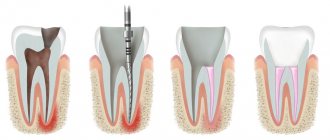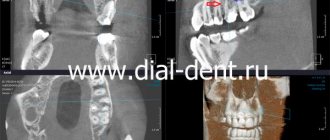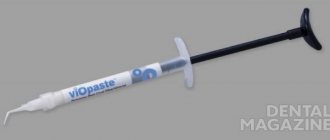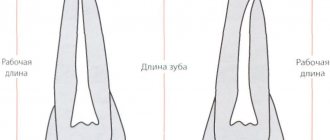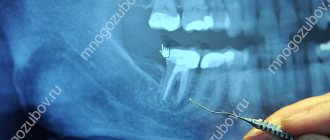Depophoresis is a method of disinfection of damaged internal tooth tissues with copper-calcium hydroxide, which increases the chances of saving complex teeth tenfold. The method is effective for narrow, winding roots. It is also suitable for re-treatment of poorly sealed canals, which cannot be completely unsealed.
Simply put, the procedure destroys pathogenic bacteria in hard-to-reach areas that cannot be treated with conventional instruments during surgical endodontic treatment.
Operating principle
Depophoresis is based on the ability of copper-calcium hydroxide to neutralize pathogenic microflora that has affected the pulp - the neurovascular bundle. Once in the canals, the substance penetrates into the farthest areas and sterilizes them. The process of proteolysis is activated: the “dead” pulp decomposes over time, and the disintegrated tissues are resorbed.
In addition to its disinfectant properties, copper-calcium hydroxide is also believed to stimulate bone formation. It is able to create an alkaline environment in which inflammatory processes cease and conditions for normal bone regeneration are created.
To ensure better passage of the substance through the channels, devices are used that deliver weak current discharges to the tooth. Under the influence of current, copper-calcium hydroxide ions move faster, their trajectory expands, and they spread along the channel.
Scope of application in dentistry
The author of the method, German professor Adolf Knappvost, proposed depophoresis as an alternative to traditional endodontic treatment. According to his research, a positive result from disinfection of canals with copper-calcium hydroxide was observed in 95% of all cases.
However, domestic studies have shown that such high rates cannot be achieved. On the one hand, this difference in research results could be explained by the fact that domestic dentists used other devices instead of the equipment recommended by Knappvost.
On the other hand, living evidence that the method itself is not a universal panacea and does not always work, still speaks for itself. And you can't dispute them.
Yes, this method is undoubtedly effective. But only in combination with classical endodontic measures. For example, the canals are widened with endodontic instruments as far as possible, and then the areas that cannot be penetrated by the instrument are treated with copper-calcium hydroxide.
Indications
The most important indication is the impossibility of carrying out full endodontic treatment due to too narrow and impassable canals or those whose course is not visible at all. Since it is not possible to “pass” the entire length of the canals with conventional instruments, doctors resort to depophoresis.
Instead of instrumental removal of the affected pulp, it is chemically sterilized with copper-calcium hydroxide.
It is also recommended for patients with previously poorly filled canals in case of re-inflammation of the pulp.
Prescribed for:
- pulpitis;
- chronic periodontitis;
- cyst in the area of the root apex;
- the presence of gangrenous contents and/or dead tissue in the root;
- enlargement of the apical foramen. Nutrients and minerals enter the tooth through this hole.
Not indicated for patients with an allergy to copper, acute periodontitis, or a silver pin in the root. Also not performed on pregnant women.
Tooth affected by pulpitis
Indications for the procedure
The method is not always used. The procedure is relevant only if it is not possible to properly fill the canal. Typically the indications are as follows:
- curved root canals;
- presence of tool remains in the channel;
- cyst or damage to the root;
- root perforation;
- apical foramen;
- obliterated channels;
- dead tissue with gangrene.
Depophoresis can solve endodontic problems. Doctors can influence the microflora of root canals in this way. In simple cases of treatment this method is not used. They are mainly prescribed in difficult cases with curved or inflamed canals. The injected drug has a potent effect and penetrates into inflamed areas without damaging healthy tissue.
The doctor can use this method at the request of the patient. The main motive is to avoid complications during dental treatment.
Copper hydroxide for depophoresis procedure
Devices for depophoresis
The device directs weak current charges to the problem tooth and stimulates the spread of copper-calcium hydroxide through the canal.
Adolf Knappvost exclusively used the Original II, manufactured by Humanchemie. This equipment is the only one approved for working according to the original method of Adolf Knappvost.
However, the alternatives are:
- "EndoEst" is also used for electroodontodiagnostics, electrophoresis, narrowing of the apical foramen, etc.;
- AOK 1.0 Modis – portable device with a graphic indicator;
- AOK 1.1 Endo-lux – equipment for electrophoresis, used as an alternative to Original II Humanchemie;
- AOK 2.1 is a compact device for depophoresis and various physiotherapeutic procedures.
Devices for depophoresis
Depophoresis
Tooth depophoresis is a modern method of root canal treatment based on the use of a weak electric field and copper-calcium hydroxide. The technique turns out to be effective, as it allows for high-quality disinfection of dental canals before the filling procedure. Copper has a powerful bactericidal effect, penetrates into everything, even the most complex tubules, guaranteeing 100% disinfection. Hydroxide also promotes the natural formation of bone tissue. To perform depophoresis in dentistry, there must be certified equipment.
Features of the depophoresis method
The technology makes it possible to eliminate necrotic tissue in the main tooth canals and complex, ornate tubules. This type of dental care is relevant for pulpitis, periodontitis, caries, as well as cysts.
Depophoresis allows you to eliminate the cyst without the need for surgery. The composition of copper-calcium hydroxide provides a powerful antibacterial effect, thereby achieving 100% sterility of the canals.
Depophoresis in dentistry is used:
- if the root canals are difficult to navigate or curved;
- with wide apical foramina;
- if poor-quality dental treatment was performed and part of the broken instrument ended up in the canal;
- when a cyst forms at the root apex;
- for pulpitis, osteolysis, periodontitis;
- if there is gangrenous content in the duct;
- if the tooth has already been filled.
After the dentist has performed depophoresis, the ducts become sterile and protected from the penetration of microorganisms. There is a high guarantee that the tooth will remain in this condition throughout its life.
Depophoresis is not recommended:
- pregnant women (especially in the first trimester);
- nursing mothers;
- if you are allergic to copper;
- in acute form of periodontitis;
- if the tooth canal is blocked by a pin;
- in cases of intolerance to weak currents;
- for diseases of the nervous system.
Depophoresis is not a panacea for the treatment of root canals, but in most cases it gives a chance to preserve the root and crown and allows you to save the dental unit.
Competitive advantages of depophoresis:
- the success of such treatment is almost 100%;
- the mechanical stability of the tooth root is maintained after therapy;
- it is possible to achieve absolute sterility;
- the technique allows you to process roots that cannot be accessed with tools;
- the procedure is performed relatively quickly;
- resection of the root apex is excluded;
- the process is relatively comfortable, the person tolerates it positively;
- affordable price.
Treatment with depophoresis
As a rule, dental treatment with depophoresis occurs in three stages. There should be a break of a week between visits to the dentist. The procedure is performed exclusively on devitalized teeth.
Stages of depophoresis:
1. The dentist diagnoses the patient’s pathological tooth, administers anesthesia, and prepares the canals for further treatment. The specialist must widen the orifice as much as possible to subsequently create a high-quality depot for the medicine. A negatively charged electrode is inserted into the mouth, and another is installed on the surface of the cheek.
2. Along with the discharge, a flow of copper-calcium hydroxide is directed into the duct, and a weak electric field is also applied. Ions gradually pass through the channels, disinfecting them.
3. The dentist treats the canal with distilled water.
The average period of work with one tooth is 5-10 minutes. To get the perfect effect, you will need about 3 procedures. Next, the dentist places a permanent filling.
As a result of this treatment, no pathogenic bacteria remain in the roots of the teeth, the remaining pulp is broken down, the canals heal quickly and no longer bother the patient, and the pulpless tooth is preserved.
Devices for depophoresis in dentistry
To carry out the procedure, a special apparatus for depophoresis is required. Modern dentistry installations include such devices from leading European manufacturers. One of the most popular is Original II Humanchemie, which was approved by the authors of the development. But there are other analogues that are also approved for use in Russia.
Dentistry "32 Dent" has equipment that allows you to perform depophoresis of tooth root canals - with high quality, inexpensively and with a guarantee. Make an appointment with your dentist to determine the need for depophoresis and solve your existing dental problem.
If you have a problem similar to that described in this article, be sure to contact our specialists. Don't diagnose yourself!
Why you should call us now:
- We will answer all your questions in 3 minutes
- Free consultation
- The average work experience of doctors is 12 years
- Convenient location of clinics
Single contact phone number: +7
Make an appointment
Sources:
- Personal experience as a dentist;
- Fedotova Yu.M., Demirova A.N. The use of copper-calcium hydroxide depophoresis for the treatment of caries complications in teeth with impassable and hard-to-reach root canals. // International student scientific bulletin. – 2016;
- Borovsky E.V., Ivanov V.S., Maksimovsky Yu.M., Maksimovskaya L.N. Therapeutic dentistry. Textbook / - M.: Medicine, 2001;
- Ahn S. et al. Evaluation of antimicrobial effect of different imqating solutions for root canal dentinal tubule disinfection X KOHrpecc 3HOARTHA today Monxes, 2001;
- Bartha T. et al. Querschnittskonfigurationen von unteren Pr malaren in der N he des apkalen Foramens Endodontie. 2004;
- Can S. et al. The efectiveness of increased apical enlargement in reducing intracanal bacterial Endod. 2002.
Description of the procedure
The pulp must first be devitalized, that is, it must stop performing all its functions, including the function of transmitting nerve impulses in response to pain.
Three sessions are required:
- In the first session, the doctor widens the root canal, fills it with copper-calcium hydroxide to a third or two-thirds of its depth and places electrodes in the patient's mouth.
- Then the depophoresis device is turned on, delivering a weak current discharge to the problem tooth. The process ends with the installation of a temporary filling.
- After 8-14 days, at the second session, the procedure is repeated. This is the optimal interval at which the risk of irritation from the application of current is zeroed out.
- At the last third session, the root is filled with atacamite, a special alkaline cement, and the canal is “closed” with a permanent filling.
Nuances of the treatment process
The procedure is minimally invasive, patients do not feel pain. There may only be unpleasant sensations from the application of current.
When working in the frontal area, after each session the oral cavity is thoroughly washed with highly dispersed copper-calcium hydroxide. This is necessary to prevent staining of the enamel.
The result of therapy can be known no earlier than six months later. As a rule, the results are positive and allow you to extend the life of “dead” teeth. After therapy, all patients must be in a dispensary group and regularly observed by a dentist.
Scheme of depopheresis
Stages of the procedure
The procedure is carried out in three stages. To avoid pain, the doctor suggests injecting local anesthesia. Using a bur, the cavity is expanded to the required size. An electrode with a negative charge is inserted into the dental canal to a depth of eight millimeters, and a positive one is applied to the outer part of the cheek opposite the diseased tooth. So that when an electrode with a + charge is applied, it does not affect all teeth.
After installing the electrodes, a low power charge is started. In parallel with the charge, a solution of copper-calcium hydroxide enters the channel. At the first stage, all bacteria are disinfected and the canal tissues are completely neutralized.
After ten minutes, the electrodes are removed and the channel is washed with water. For rinsing, use 10% calcium hydroxide or ordinary purified water. A paste-like hydroxide solution is immersed in a clean channel.
When a tooth has several roots, the above procedure is performed on each root separately. When all channels are filled with solution at the same time, the quality of treatment drops sharply.
At the first stage, the canals are prepared for the upcoming treatment and disinfected. At the second stage, the procedure is repeated in the same way as at stage 1. The third stage is completion of treatment. The dentist carries out manipulations already familiar to the patient and seals the canals with special cement to prevent infection from getting into them.
The interval between stages of treatment is 7–14 days. The minimum period is a week.
Advantages
- Suitable for patients who cannot clean the canals in the traditional way: due to obstruction of the canals, as a result of dentist mistakes;
- sterilization ensures minimal risks of re-infection;
- high percentage of positive results. From 60-70 to 95% according to various studies;
- speed, simplicity and painlessness;
- allows you to avoid resection of the root apex in chronic periodontitis.
Below is a list of dentists that successfully practice complex root canal treatment using depophoresis.
